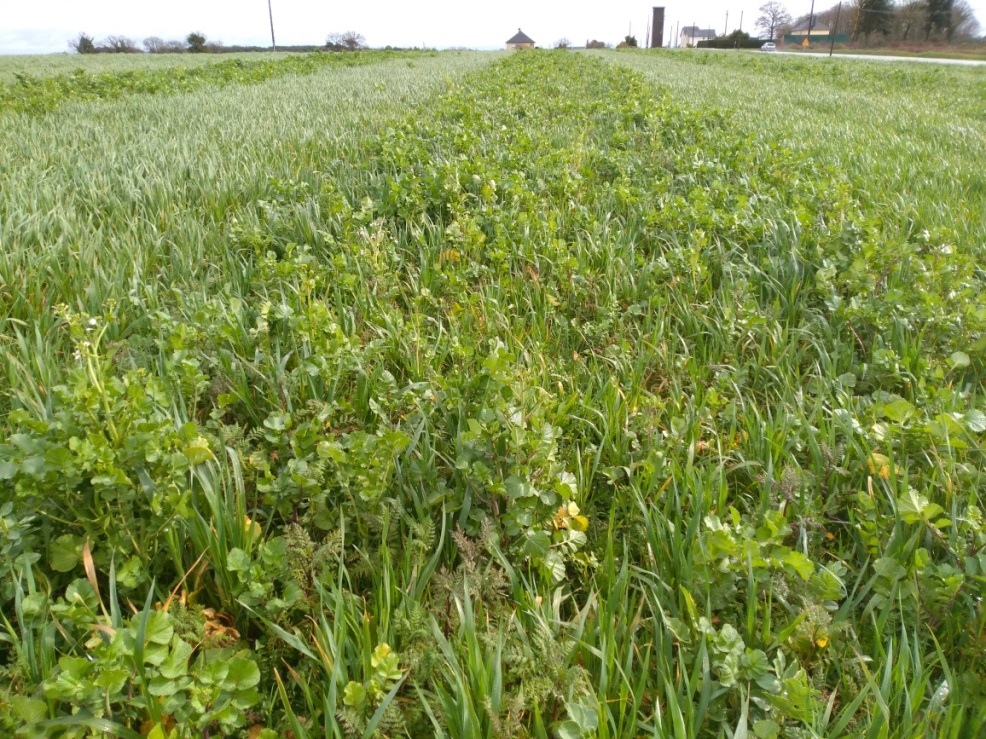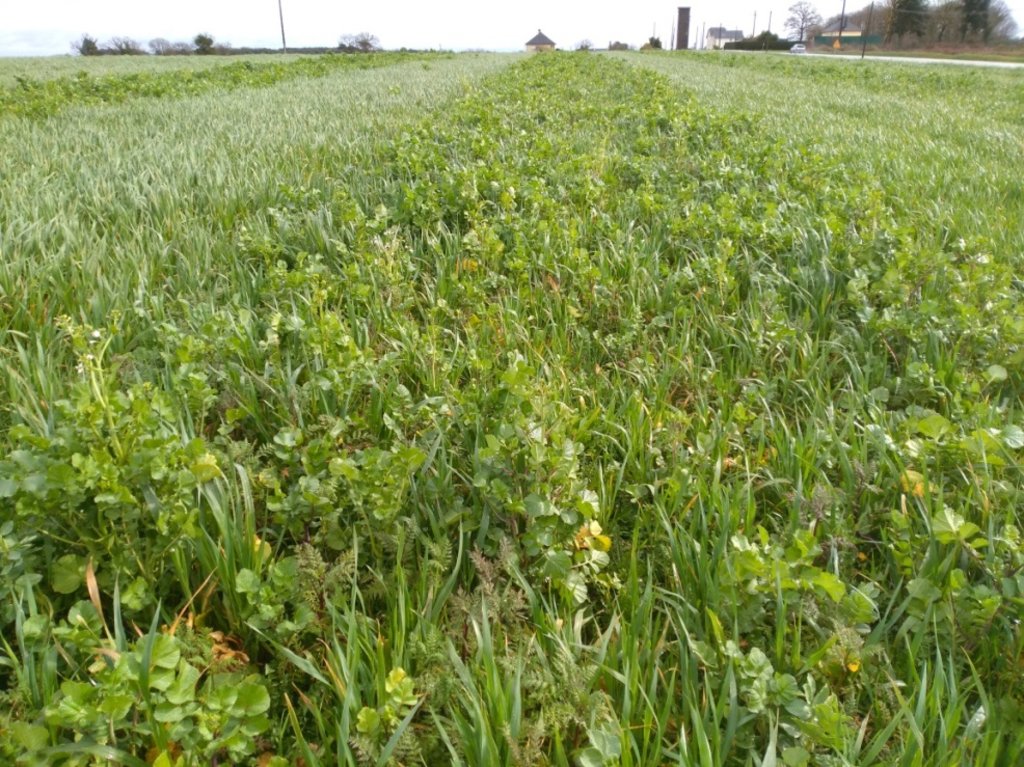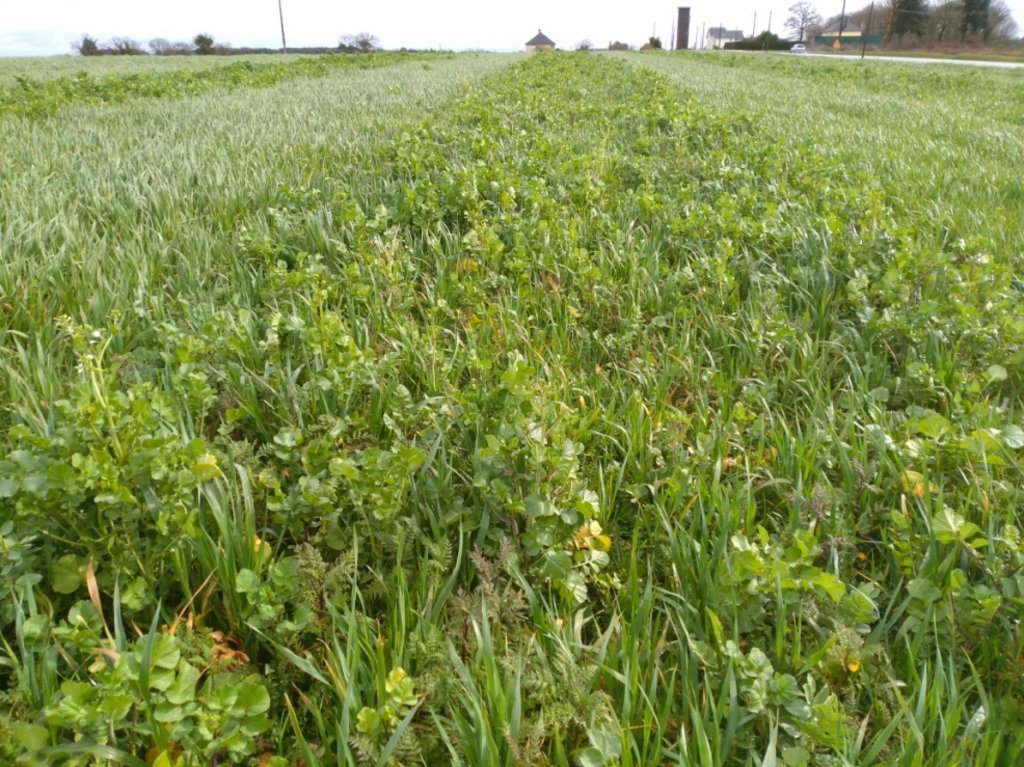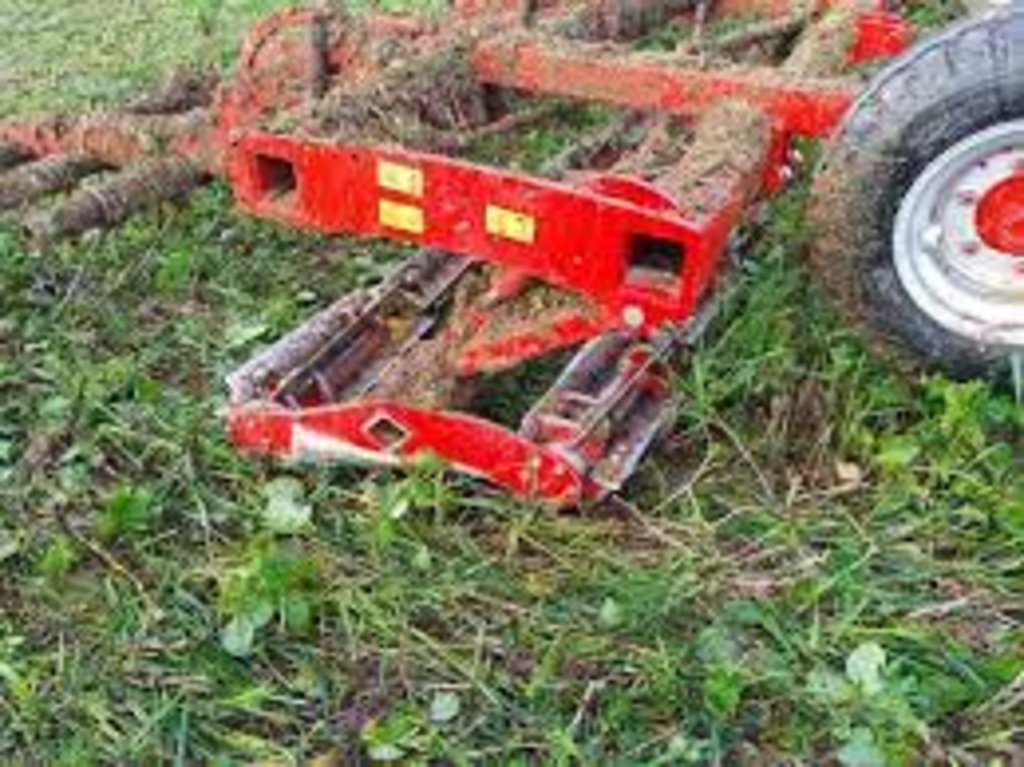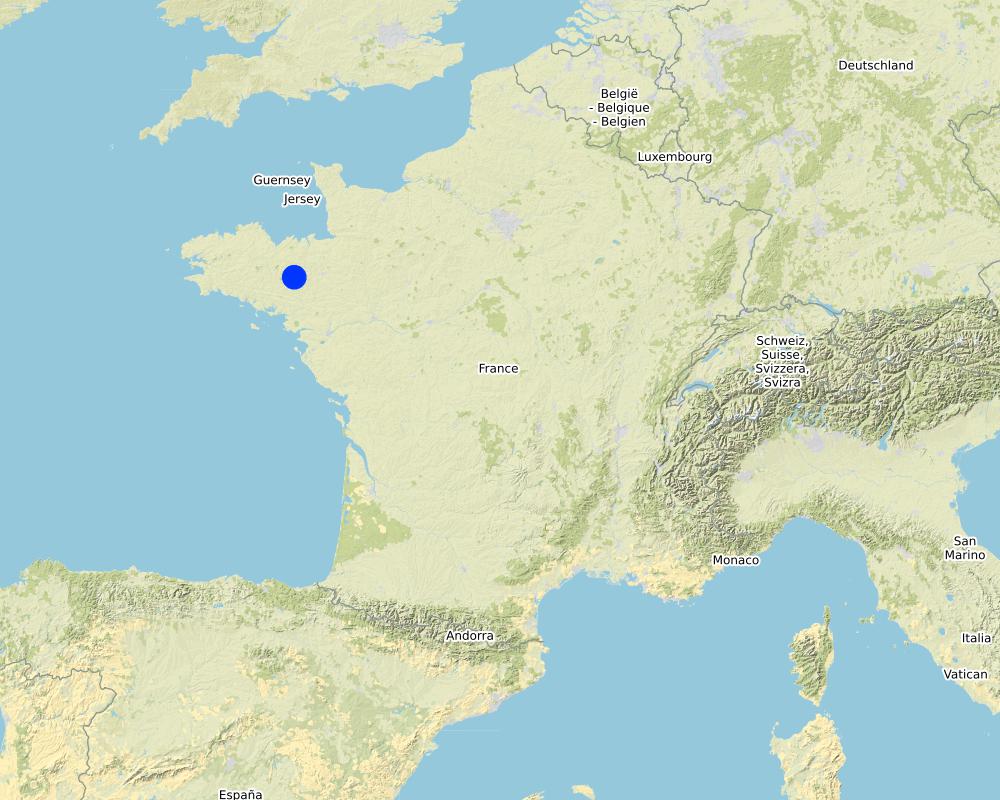Vegetation cover management on an organic, mixed livestock-crop farm [France]
- Creation:
- Update:
- Compiler: Alan Radbourne
- Editors: David Robinson, David Norris, Sabine Reinsch
- Reviewers: Rima Mekdaschi Studer, William Critchley
technologies_5680 - France
View sections
Expand all Collapse all1. General information
1.2 Contact details of resource persons and institutions involved in the assessment and documentation of the Technology
Key resource person(s)
co-compiler:
Joubioux Christiane
Chambre regionale d'agriculture de Bretane: Regional chambre of agriculture of Brittany
France
land user:
Le Callonnec Patrice
NA
France
SLM specialist:
Guiet Sylvie
Chambre regionale d'agriculture de Bretane: Regional chambre of agriculture of Brittany
France
1.3 Conditions regarding the use of data documented through WOCAT
The compiler and key resource person(s) accept the conditions regarding the use of data documented through WOCAT:
Yes
1.4 Declaration on sustainability of the described Technology
Is the Technology described here problematic with regard to land degradation, so that it cannot be declared a sustainable land management technology?
No
2. Description of the SLM Technology
2.1 Short description of the Technology
Definition of the Technology:
Use of different mixes of plant cover for livestock fodder which are simultaneously favourable for biodiversity by improving soil health, and reducing the need for agrochemicals.
2.2 Detailed description of the Technology
Description:
Agriculture in Brittany, in the north-west of France, is known for fish, beef, pork, poultry, vegetables and milk. Cover crops are used by farmers of Mauron, and the example described here is from a farm located in Morbihan in the basin known as Ploërmel. In this warm temperate area the average annual rainfall is 650-700 mm with an annual temperature of around 11°C.
There are three types of cover crops included in the rotation. These are selected on the basis of their benefits in relation to soil fertility and fodder production, in order to improve the farm's food self-sufficiency. There are three basic types of cover crops, as follows.
1) “Protein mixes” are composed of 35% faba (broad) beans, 26% oats, 17.5% peas, 17.5% vetch, and 4% clover. These are sown in early October after grass or maize are made into silage at the end of April.
2) "Green manure" cover crops are sown at the beginning of September after cereals, and are composed of various complementary species with the main objective of preserving and strengthening soil life (i.e. worm abundance), and winter feeding of heifers. For example, the commercial "Biomax" mix contains seeds of broad bean, vetch, clover, phacelia and radish. These cover crops are enriched by the presence of approximately 50% ryegrass regrowth, supporting the development of soil life.
3) Rapeseed is sown after cereals as a crop rotation feedstock and are made into silage.
Cover crops are either broadcast and rolled, or direct seeded depending on the conditions of the post-harvest plots. The seed drill used is equipped with discs to minimise soil disturbance as a reduced tillage technique, but more important in this respect is the presence of crop residues (i.e. straw). The seed drill is also equipped with tines.
The cover crops are grazed by heifers in a rotational 2-day paddock set-up. After grazing and regrowth of the ryegrass present, the fields may be left to develop into pasture, or seeded to crops using a minimum tillage drill.
The purposes are:
•Improved production
•Countered land degradation
•Protected watersheds
•Preserved biodiversity
•Adaptation to climate change/extreme events
The benefits are:
•Sustained ecosystem health: no pest and disease problems, good herd health
•Enrichment of the soil by the addition of carbon in organic matter and by the work of earthworms - favouring ecosystem functioning
•Protection of the soil and surface biodiversity because of maintained plant cover
•Increased weed control due to plant canopies and fertilisation effect of green manure
•Planted cover crops used as livestock feed during winter
The challenges are:
•Potential difficulties in establishing plant cover (especially in dry areas)
•Late sowing of cover crops reduces beneficial effects
•High costs of seed mixtures with high protein cover crops
2.3 Photos of the Technology
2.5 Country/ region/ locations where the Technology has been applied and which are covered by this assessment
Country:
France
Region/ State/ Province:
Brittany
Further specification of location:
Mauron
Specify the spread of the Technology:
- evenly spread over an area
If precise area is not known, indicate approximate area covered:
- 10-100 km2
Is/are the technology site(s) located in a permanently protected area?
No
Map
×2.6 Date of implementation
Indicate year of implementation:
2019
If precise year is not known, indicate approximate date:
- less than 10 years ago (recently)
2.7 Introduction of the Technology
Specify how the Technology was introduced:
- through land users' innovation
- as part of a traditional system (> 50 years)
Comments (type of project, etc.):
In order to make their production system evolve, farmers and their associates are eager for information. They do not hesitate to go and see what is happening elsewhere and to consult: training, visits, reading, internet, exchanges. The land user is a member of the BASE (Biodiversity Agriculture Soil and Environment) network and the Ecosystem association. Breeders do not hesitate to test new production practices on their farms.
3. Classification of the SLM Technology
3.1 Main purpose(s) of the Technology
- improve production
- reduce, prevent, restore land degradation
- protect a watershed/ downstream areas – in combination with other Technologies
- preserve/ improve biodiversity
- adapt to climate change/ extremes and its impacts
3.2 Current land use type(s) where the Technology is applied
Land use mixed within the same land unit:
Yes
Specify mixed land use (crops/ grazing/ trees):
- Agro-pastoralism (incl. integrated crop-livestock)

Cropland
- Annual cropping
- Cover crops
Annual cropping - Specify crops:
- cereals - maize
- cereals - rye
- fodder crops - clover
- fodder crops - grasses
- fodder crops - other
- legumes and pulses - beans
- oilseed crops - sunflower, rapeseed, other
Number of growing seasons per year:
- 1
Is intercropping practiced?
Yes
If yes, specify which crops are intercropped:
protein mix, a multi-species green manure, and a rapeseed mix
Is crop rotation practiced?
Yes
If yes, specify:
Maize, grassland

Grazing land
Intensive grazing/ fodder production:
- Cut-and-carry/ zero grazing
- Improved pastures
Animal type:
- cattle - dairy
- poultry
Is integrated crop-livestock management practiced?
Yes
If yes, specify:
Dairy and poultry moved across crop for fodder and cross benefits of fertilisation.
Species:
cattle - dairy
Count:
115
Species:
poultry
Count:
4500
3.3 Has land use changed due to the implementation of the Technology?
Has land use changed due to the implementation of the Technology?
- No (Continue with question 3.4)
3.4 Water supply
Water supply for the land on which the Technology is applied:
- rainfed
3.5 SLM group to which the Technology belongs
- integrated crop-livestock management
- improved ground/ vegetation cover
- integrated pest and disease management (incl. organic agriculture)
3.6 SLM measures comprising the Technology

agronomic measures
- A1: Vegetation/ soil cover
- A2: Organic matter/ soil fertility
- A3: Soil surface treatment
- A4: Subsurface treatment
3.7 Main types of land degradation addressed by the Technology

soil erosion by water
- Wt: loss of topsoil/ surface erosion
- Wg: gully erosion/ gullying
- Wo: offsite degradation effects

chemical soil deterioration
- Cn: fertility decline and reduced organic matter content (not caused by erosion)

physical soil deterioration
- Pc: compaction

biological degradation
- Bc: reduction of vegetation cover
- Bq: quantity/ biomass decline
- Bs: quality and species composition/ diversity decline
- Bp: increase of pests/ diseases, loss of predators

water degradation
- Hp: decline of surface water quality
- Hw: reduction of the buffering capacity of wetland areas
3.8 Prevention, reduction, or restoration of land degradation
Specify the goal of the Technology with regard to land degradation:
- prevent land degradation
- reduce land degradation
4. Technical specifications, implementation activities, inputs, and costs
4.1 Technical drawing of the Technology
Technical specifications (related to technical drawing):
- broadcast sowing or direct sowing of species mixture in late August / early September or late September / early October
- protein mix: peas 40 kg / faba (broad) beans 80 kg / vetch 40 kg / clover 8 kg / oats 60 kg per hectare
- Biomax mix: radish 2 kg / clover 3 kg / faba (broad) bean 20 kg / phacelia 2 kg / vetch 10 kg per hectare
- Rapeseed mix: 8 to 10 kg per hectare
Author:
Revue agricole Terra
Date:
21/06/2013
4.2 General information regarding the calculation of inputs and costs
Specify how costs and inputs were calculated:
- per Technology area
Indicate size and area unit:
1 ha
other/ national currency (specify):
€
If relevant, indicate exchange rate from USD to local currency (e.g. 1 USD = 79.9 Brazilian Real): 1 USD =:
0.9
Indicate average wage cost of hired labour per day:
Gross hourly minimum wage: €10.15 on 1 January 2020, i.e. €1,539.42 monthly on the basis of the legal working week of 35 hours.
4.3 Establishment activities
| Activity | Timing (season) | |
|---|---|---|
| 1. | Soil preparation and subsequent sowing of rapeseed/rapeseed after harvest cereals | End of August |
| 2. | Soil preparation and sowing of the Biomax mixture after harvest cereals | End of August |
| 3. | Soil preparation and sowing of meslin after grassland or corn on the cob | End of October |
| 4. | Rapeseed/rapeseed grazing and growing of green manure | December to March |
| 5. | Meslin silage | April |
4.4 Costs and inputs needed for establishment
| Specify input | Unit | Quantity | Costs per Unit | Total costs per input | % of costs borne by land users | |
|---|---|---|---|---|---|---|
| Equipment | Direct seeding (compil) | ha | 40.0 | 60.0 | 2400.0 | 100.0 |
| Equipment | Broadcast sowing | ha | 72.0 | 15.0 | 1080.0 | 100.0 |
| Equipment | Roller spade before sowing (1 pass) | ha | 72.0 | 23.0 | 1656.0 | 100.0 |
| Equipment | Maceration by a roller with blades | ha | 224.0 | 23.0 | 5152.0 | 100.0 |
| Plant material | Seeds - protein blend | ha | 60.0 | 394.0 | 23640.0 | 100.0 |
| Plant material | Seeds - forage rapeseed | ha | 17.0 | 28.0 | 476.0 | 100.0 |
| Plant material | Seeds - green manure "biomax" fertilizer | ha | 18.0 | 60.0 | 1080.0 | 100.0 |
| Total costs for establishment of the Technology | 35484.0 | |||||
| Total costs for establishment of the Technology in USD | 39426.67 | |||||
Comments:
Costs for seeds refer to purchased seed, if farm-saved seed, the cost is reduced
4.5 Maintenance/ recurrent activities
Comments:
No maintenance costs just time to rotationally graze livestock and poultry
4.6 Costs and inputs needed for maintenance/ recurrent activities (per year)
Comments:
No maintenance activities, future years would repeat establishment activities
4.7 Most important factors affecting the costs
Describe the most determinate factors affecting the costs:
Direct sowing equipment, destruction with 2 passes of rolling spade, cost of purchasing "biomax" mixture
5. Natural and human environment
5.1 Climate
Annual rainfall
- < 250 mm
- 251-500 mm
- 501-750 mm
- 751-1,000 mm
- 1,001-1,500 mm
- 1,501-2,000 mm
- 2,001-3,000 mm
- 3,001-4,000 mm
- > 4,000 mm
Specify average annual rainfall (if known), in mm:
675.00
Specifications/ comments on rainfall:
The farm is located on the commune of Mauron in Morbihan and is in an early agro-climatic zone. The average annual rainfall of 650-700 mm is the lowest in Morbihan. The average annual temperature of around 11°C and is also the lowest in Morbihan.
Indicate the name of the reference meteorological station considered:
Ploermel
Agro-climatic zone
- sub-humid
The climate of Mauron is warm and temperate. It is in the basin known as Ploërmel, the most continental of Morbihan with colder winters, hotter summers and rainfall of around 650-700 mm/year. Heavy showers fall all year round in the area of Mauron. Even in the driest months, rainfall remains fairly heavy.
5.2 Topography
Slopes on average:
- flat (0-2%)
- gentle (3-5%)
- moderate (6-10%)
- rolling (11-15%)
- hilly (16-30%)
- steep (31-60%)
- very steep (>60%)
Landforms:
- plateau/plains
- ridges
- mountain slopes
- hill slopes
- footslopes
- valley floors
Altitudinal zone:
- 0-100 m a.s.l.
- 101-500 m a.s.l.
- 501-1,000 m a.s.l.
- 1,001-1,500 m a.s.l.
- 1,501-2,000 m a.s.l.
- 2,001-2,500 m a.s.l.
- 2,501-3,000 m a.s.l.
- 3,001-4,000 m a.s.l.
- > 4,000 m a.s.l.
Indicate if the Technology is specifically applied in:
- not relevant
Comments and further specifications on topography:
The minimum and maximum altitudes in Mauron are 47 m and 130 m respectively.
5.3 Soils
Soil depth on average:
- very shallow (0-20 cm)
- shallow (21-50 cm)
- moderately deep (51-80 cm)
- deep (81-120 cm)
- very deep (> 120 cm)
Soil texture (topsoil):
- medium (loamy, silty)
Soil texture (> 20 cm below surface):
- coarse/ light (sandy)
- medium (loamy, silty)
Topsoil organic matter:
- high (>3%)
If available, attach full soil description or specify the available information, e.g. soil type, soil PH/ acidity, Cation Exchange Capacity, nitrogen, salinity etc.
The farm is located in the commune of Mauron in Morbihan and is in the geological zone of the Briovician shales.
It contains :
UCS n°4034 Brown soils gradually leached from the plains and plateaus from locally soft schist sandstone.
UCS n°4022 Shallow, sometimes podzolic soils of locally sandstone mounds and brown leached soils of open plains, derived from soft schist.
5.4 Water availability and quality
Ground water table:
5-50 m
Availability of surface water:
medium
Water quality (untreated):
poor drinking water (treatment required)
Water quality refers to:
both ground and surface water
Is water salinity a problem?
No
Is flooding of the area occurring?
No
5.5 Biodiversity
Species diversity:
- high
Habitat diversity:
- high
5.6 Characteristics of land users applying the Technology
Sedentary or nomadic:
- Sedentary
Market orientation of production system:
- commercial/ market
Off-farm income:
- less than 10% of all income
Relative level of wealth:
- average
Individuals or groups:
- groups/ community
Level of mechanization:
- mechanized/ motorized
Gender:
- men
Age of land users:
- youth
- middle-aged
5.7 Average area of land used by land users applying the Technology
- < 0.5 ha
- 0.5-1 ha
- 1-2 ha
- 2-5 ha
- 5-15 ha
- 15-50 ha
- 50-100 ha
- 100-500 ha
- 500-1,000 ha
- 1,000-10,000 ha
- > 10,000 ha
Is this considered small-, medium- or large-scale (referring to local context)?
- large-scale
Comments:
The farm has been involved in organic farming since 1964 when Claudine's father settled on a 45-hectare dairy farm. The regrouping was carried out in 1968.
As the associates' facilities have been installed, the size of the farm has increased to reach a useful agricultural area of 220 hectares in 2020.
The farm has 3 main operating areas:
- dairy cattle with about 115 dairy cows (average of 7 to 8000 litres/year),
- poultry with 4500 laying hens, and a
- production of cash crops.
5.8 Land ownership, land use rights, and water use rights
Land ownership:
- individual, titled
Land use rights:
- leased
- provisioning
Water use rights:
- individual
Are land use rights based on a traditional legal system?
Yes
Specify:
lease
5.9 Access to services and infrastructure
health:
- poor
- moderate
- good
education:
- poor
- moderate
- good
technical assistance:
- poor
- moderate
- good
employment (e.g. off-farm):
- poor
- moderate
- good
markets:
- poor
- moderate
- good
energy:
- poor
- moderate
- good
roads and transport:
- poor
- moderate
- good
drinking water and sanitation:
- poor
- moderate
- good
financial services:
- poor
- moderate
- good
6. Impacts and concluding statements
6.1 On-site impacts the Technology has shown
Socio-economic impacts
Production
crop production
Comments/ specify:
Improved soil health and diversity with reduces pest issues
crop quality
Comments/ specify:
Improved soil health and diversity with reduces pest issues
fodder production
Comments/ specify:
Improved soil health and diversity with reduces pest issues
fodder quality
Comments/ specify:
Improved soil health and diversity with reduces pest issues
animal production
Comments/ specify:
Better diversity of fodder available is producing healthier and better quality animals
product diversity
Comments/ specify:
Sward mix in cover crop is very diverse
Water availability and quality
drinking water quality
Comments/ specify:
Cover crops reduce soil wash-off and other water quality related impacts
water availability for livestock
Comments/ specify:
Cover crops reduce soil wash-off and other water related loss impacts
water quality for livestock
Comments/ specify:
Cover crops reduce soil wash-off and other water quality related impacts
Income and costs
farm income
Comments/ specify:
Improved crop and animal production
workload
Comments/ specify:
Greater workload to rotationally graze and manage crop effectively in an organic system (i.e. can't rely on spraying to solve problems). Yet, benefits outweigh extra workload.
Socio-cultural impacts
SLM/ land degradation knowledge
Comments/ specify:
Vastly improved understanding through SLM expert advice and practical learning from doing SLM technology.
Ecological impacts
Water cycle/ runoff
water quantity
Comments/ specify:
Cover crops help maintain soil moisture and reduce runoff through root system, improving water quantity held in field.
water quality
Comments/ specify:
Cover crops reduce soil wash-off and other water quality related impacts
surface runoff
Comments/ specify:
Cover crops reduce soil wash-off and other water quality related impacts
evaporation
Comments/ specify:
Cover crops help maintain soil moisture and reduce runoff through root system, improving water quantity held in field.
Soil
soil moisture
Comments/ specify:
Cover crops help maintain soil moisture and reduce runoff through root system, improving water quantity held in field.
soil cover
Comments/ specify:
Cover crops design is to cover soil and reduce soil loss
soil loss
Comments/ specify:
Cover crops design is to cover soil and reduce soil loss
soil crusting/ sealing
Comments/ specify:
Cover crops design is to cover soil and reduce soil crusting
soil compaction
Comments/ specify:
Reduced tillage techniques and less passes across fields with machinery as no spraying due to organic system reduces compaction.
nutrient cycling/ recharge
Comments/ specify:
Selected species of cover crops help recharge nutrient availability in the soil
soil organic matter/ below ground C
Comments/ specify:
Cover crop rooting system & waste inversion as green manure increases the soil organic matter below ground.
Biodiversity: vegetation, animals
Vegetation cover
Comments/ specify:
Cover crops design is to cover soil and reduce soil crusting
biomass/ above ground C
Comments/ specify:
Greater crop cover and thus more biomass above ground
plant diversity
Comments/ specify:
Well designed mixed cover crop seed mixes, although more expensive, provide a specialised plant diversity ideal for the farm system requirements.
beneficial species
Comments/ specify:
Certain cover crops can attract beneficial species and help control pests and diseases
habitat diversity
Comments/ specify:
A diverse vegetation supports greater habitat diversity
pest/ disease control
Comments/ specify:
Certain cover crops can attract beneficial species and help control pests and diseases
Climate and disaster risk reduction
flood impacts
Comments/ specify:
Cover crops slow surface runoff and can hold a greater water capacity reducing flood risk and impact
landslides/ debris flows
Comments/ specify:
Cover crops slow surface run off and can hold a greater water capacity reducing potential for debris flows in storm events
drought impacts
Comments/ specify:
Cover crops slow surface runoff and can hold a greater water capacity reducing drought impacts
6.2 Off-site impacts the Technology has shown
downstream flooding
Comments/ specify:
Cover crops slow surface runoff and can hold a greater water capacity reducing flood risk and impact
groundwater/ river pollution
Comments/ specify:
Cover crops slow surface runoff and can hold a greater water capacity reducing potential for debris flows and nutrient leaching downstream
buffering/ filtering capacity
Comments/ specify:
Cover crops slow surface runoff and can hold a greater water capacity reducing potential for debris flows and nutrient leaching downstream
6.3 Exposure and sensitivity of the Technology to gradual climate change and climate-related extremes/ disasters (as perceived by land users)
Gradual climate change
Gradual climate change
| Season | increase or decrease | How does the Technology cope with it? | |
|---|---|---|---|
| annual temperature | increase | not known | |
| annual rainfall | increase | not known |
Climate-related extremes (disasters)
Meteorological disasters
| How does the Technology cope with it? | |
|---|---|
| local thunderstorm | not known |
| local hailstorm | not known |
6.4 Cost-benefit analysis
How do the benefits compare with the establishment costs (from land users’ perspective)?
Short-term returns:
slightly positive
Long-term returns:
slightly positive
How do the benefits compare with the maintenance/ recurrent costs (from land users' perspective)?
Short-term returns:
neutral/ balanced
Long-term returns:
neutral/ balanced
6.5 Adoption of the Technology
- 11-50%
Of all those who have adopted the Technology, how many did so spontaneously, i.e. without receiving any material incentives/ payments?
- 11-50%
6.6 Adaptation
Has the Technology been modified recently to adapt to changing conditions?
Yes
other (specify):
Livestock feeding, economic interest, societal expectations
Specify adaptation of the Technology (design, material/ species, etc.):
Species are selected according to their ability to cover, feed and work the soil. To do this, species are chosen for their diversity and complementary according to their root system: tap roots, adventitious roots, surface lateral roots, etc.
For the past 2 years, the Biomax green manure + RGA regrowth mix has been grazed by heifers.
6.7 Strengths/ advantages/ opportunities of the Technology
| Strengths/ advantages/ opportunities in the land user’s view |
|---|
| Sustain ecosystem health: no pest and disease problems, good herd health. |
| Carbon sequestration by enrichment of the soil with organic matter and by the work of earthworms favouring ecosystem functioning. |
| Protection of the soil and surface biodiversity because of maintained plant cover. |
| Increased weed control due to plant canopies and fertilisation effect of green manure. |
| Planted cover crops used as livestock feed during winter. |
| Sustained ecosystem integrity reduces/counters ecosystem degradation by using multiple ecosystem functions: Complementarity, Continuity of soil life, Green fertilizer essential in the farming system, Feeding the livestock. |
| Strengths/ advantages/ opportunities in the compiler’s or other key resource person’s view |
|---|
| Multi-species cover is conducive to soil quality: production of a high above-ground and root biomass that promotes soil life, soil structuring at depth (tap roots) and on the surface (superficial roots) by the effect of organic matter inputs. |
| Multi-species cover provides shelter and cover for small fauna: seeds for the winter survival of the fauna, plants that are tiered at different heights without being too dense for wild game to move around while being protected. |
|
The different families that can be planted under cover are: - Grasses are generally easy to grow and are valued by animals (oats, rye and sorghum). - Leguminous plants improve the performance of cover crops. They are regulating plants that trap nitrogen and fix it in the soil. This is then used by the crop that follows. - Cruciferous plants are to be reserved for cereal rotations without rapeseed or vegetables. - Compounds (nyger and sunflower) are interesting for biomass production. |
|
Well-developed canopies have a competitive effect against weeds (germination inhibition, smothering, allelopathy). The aim is to have a rapidly developing canopy. It is necessary to limit the risks of shot blasting by sowing the canopy on clean soil, especially for early sowing (especially for short-cycle weeds: ragwort, bluegrass, Persian speedwell). Some species have allelopathic effects, i.e. they secrete inhibiting substances (the intensity of the allelopathic effect is taken from the Sem-Partners catalogue, see bibliography): - Diploid oats: allelopathic effect not demonstrated. Little is known about the mechanisms and molecules involved. - Spring Oats, Fenugreek, Gesse, Moha : average allelopathic effect, mechanisms and molecules involved are not well known. - Camelina, Radish: strong allelopathic effect (glucosinolates). - Winter mustard, Spring mustard: action of glucosinolates against nematodes (Heterodera Schaati and Meloidogyne chitwoodi) in biofumigation. - Buckwheat (Sarrazin): strong allelopathic effect. Little is known about the mechanisms and molecules involved. |
| A plant cover provides additional fodder, 3 to 4 tonnes of dry matter can be produced depending on the species and sowing date. |
6.8 Weaknesses/ disadvantages/ risks of the Technology and ways of overcoming them
| Weaknesses/ disadvantages/ risks in the land user’s view | How can they be overcome? |
|---|---|
| Difficulties in establishing cover: difficult lifting in dry areas |
Conditions for successful plant cover Sow as soon as possible Take advantage of the humidity just after harvest |
| Late sowing of cover crops: no or little flowering and therefore little beneficial effect | Early establishment of complementary species |
| High cost of purchased seed of mixed protein cover crops | Self-production of farm-saved seed |
| Weaknesses/ disadvantages/ risks in the compiler’s or other key resource person’s view | How can they be overcome? |
|---|---|
| In order to increase the potential of the canopies for bees, it is necessary to sow in the first half of August for flowering in the autumn. Some species are rich in nectar or pollen: rapeseed, white mustard, phacelia, radish, sunflower, clover, vetch. However, some species have extra-floral nectar such as sunflower, vetch and faba beans. That is to say that they secrete nectar outside the flowering period. | Sow in the first half of August as soon as the cereals are harvested to take advantage of the residual moisture which is conducive to good emergence. |
| The development of RGA on the farm. | Ploughing can slow down the development of RGA. |
| The cost of destroying the canopy is high (45€/ha excluding labour) with the 2 cross passes of rolling spade. |
3) Cost of some tools for destroying the cover crops: Independent disc stubble cultivator 3m= 33€/ha Cultivator 3.5m = 20€/ha Mulcher 3m = 27 €/ha Cambridge roller 8m = 16€/ha Blade roller 3m = 17€/ha Assumptions: replacement value depreciated over 10 years + maintenance, tractor cost 20€/hour, labour not included |
| Before grazing a multi-species canopy, it is advisable to check the absence of toxic species (e.g. buckwheat) | Not known |
| The doses and costs of implementing protein blend cutlery in interculture are high. |
- Adjusting Mixed Doses - Self-production of farm-saved seeds - Mixture with recommended doses (OBS: Do not exceed 120% pure dose) |
7. References and links
7.1 Methods/ sources of information
- field visits, field surveys
GAEC Bio-yvel
- interviews with land users
Performed by Patrice Le Callonnec
- interviews with SLM specialists/ experts
Chargés d’études élevage et machinisme CRA Bretagne
- compilation from reports and other existing documentation
7.2 References to available publications
Title, author, year, ISBN:
Couvert végétal, une culture à part entière, Terra du 21 juin 2013
Available from where? Costs?
Terra (Réussir terragricoles de Bretagne) du 21 juin 2013
Title, author, year, ISBN:
Couvert végétal, de réels avantages agronomiques, Terra 12 juin 2015
Available from where? Costs?
Terra 12 juin 2015
Title, author, year, ISBN:
Couverts végétaux, la destruction possible dès le 1er février, Terra du 15 janvier 2016
Available from where? Costs?
Terra du 15 janvier 2016
7.3 Links to relevant online information
Title/ description:
Liste de plantes attractives pour les abeilles, Ministères de l’agriculture et de l’alimentation, 2017
URL:
https://agriculture.gouv.fr/decouvrez-la-liste-des-plantes-attractives-pour-les-abeilles
Title/ description:
Implanter des cultures intermédiaires à effet allélopathique ou biocide, biofumigation
URL:
https://geco.ecophytopic.fr/geco/Concept/Implanter_Des_Cultures_Intermediaires_A_Effet_Allelopathique_Ou_Biocide,_Biofumigation
Links and modules
Expand all Collapse allLinks
No links
Modules
No modules


